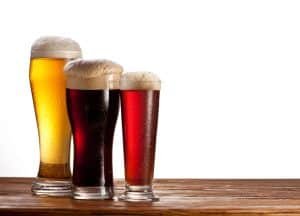
When it comes to beer, two of the most popular styles are lager and ale. But what is the difference between them? To help answer this question, it’s important to understand what makes them distinct.
Lagers are a type of beer that are created with bottom fermenting yeast, which ferments slower than top fermenting yeast. This slower fermentation process creates a smooth, refreshing, and crisp flavor. It also has a lighter color than ale due to the absence of roasted malts. Lagers typically have a higher carbonation level and lower alcohol content than ales.
Ales, on the other hand, are brewed with top fermenting yeast which ferments faster and at a higher temperature than bottom fermenting yeast. This faster fermentation process creates a fuller-bodied, maltier, and fruitier flavor. Ales also have a higher alcohol content than lagers, and a less carbonated flavor.
The differences between lager and ale don’t just stop at flavor. Each type of beer also varies in terms of production, ingredients, and brewing process. For example, lagers are brewed with a longer maturation period and at cooler temperatures, while ales are brewed at higher temperatures with a shorter maturation period.
Lagers and ales are also brewed with different types of malts and hops. Lagers are brewed with pilsner, munich, or pale malts, while ales are brewed with pale, wheat, or caramel malts. In terms of hops, lagers are brewed with noble hops while ales are brewed with Cascade, Chinook, or Centennial hops.
These are some of the key differences between lagers and ales. From production and flavor to ingredients and brewing process, there are many nuances between these two styles of beer. But what ultimately sets them apart is their distinct flavor profiles, which can make them the perfect choice for any occasion.

What’s the Difference Between Lager and Ale?
Beer is one of the oldest and most widely consumed beverages in the world. It is made by fermenting grains such as barley, wheat, and rice. While there are many different types of beer, lager and ale are two of the most popular. But what are the differences between lager and ale?
To understand the difference between lager and ale, it is important to understand the process of brewing beer. In general, beer is made by using yeast to convert the sugars in grains to alcohol. For lager, yeast is fermented at a lower temperature, which is why it is referred to as a “bottom-fermenting” beer. Ale, on the other hand, is fermented at a higher temperature and is referred to as a “top-fermenting” beer.
The temperature difference in fermentation has a significant impact on the flavor of beer. Lager is typically crisp and clean and has a more subtle flavor. Ale is usually more full-bodied and has a more complex flavor. It is also typically more bitter than lager. The color of lager is usually lighter than ale, which is usually darker.
The differences between lager and ale also extend to the types of ingredients used in brewing. While both beers use grains like barley, wheat, and rice, lager often uses maize or corn as a grain. Ale, on the other hand, is typically brewed with hops, which add a bitter flavor and aroma.
Ultimately, the differences between lager and ale come down to the brewing process and ingredients used. Lager is light, clean, and crisp and is best served cold. Ale is full-bodied and flavorful and is usually served at a slightly warmer temperature. Both styles of beer can be enjoyed by beer lovers around the world.
Are Lagers and Ales Different Types of Beer?

Beer is one of the world’s most popular alcoholic beverages. Over the years, beer has evolved into different styles, which are either lagers or ales. But what sets lagers and ales apart?
Lagers and ales are both types of beer, but the differences between them are significant. Lagers have a lighter flavor, and are usually pale, golden, or light amber in color. They are made with bottom-fermenting yeast and cold-conditioned, which helps to create a smoother, crisper flavor. Lagers typically take longer to brew than ales, due to the longer fermentation and cold-conditioning process.
Ales, on the other hand, are usually darker in color and have a more complex flavor. They are brewed with top-fermenting yeast and warm-conditioned, which helps to create a more robust flavor. Ales are usually ready to drink much faster than lagers, as the warm-conditioning process is shorter.
In terms of taste, lagers tend to have a more neutral flavor, while ales are more complex. Lagers are often described as having a “clean” taste, while ales are more aromatic and flavorful.
When it comes to alcohol content, lagers tend to have lower alcohol levels, while ales tend to be higher in alcohol. Lagers are usually best served cold, while ales can be served at a variety of temperatures.
Overall, lagers and ales are different types of beer, each with its own unique characteristics and flavors. Whether you prefer a bold, hoppy ale or a light, crisp lager, there is a beer out there for everyone.
What Are the Different Styles of Lager?
When it comes to beer, lager is one of the most popular styles. Lager is a type of beer that is fermented at cool temperatures and uses yeast that ferments at the bottom of the fermenter. As a result, lager is usually lighter in color and flavor than ales. It is also known for its crisp, refreshing taste and is the style of beer most often found in bars and restaurants.
There are many different styles of lager. The most common type is pale lager, which is a light-colored beer that is mild in flavor. Pilsner is another popular type of lager that is slightly stronger in flavor than pale lager. Bock is a dark-colored lager that is full-bodied and has a malty flavor. Other styles of lager include Munich Helles, American Lager, Kölsch, and Schwarzbier.
When it comes to choosing a lager, it can be helpful to consider the type of food you’re serving. For instance, a light-bodied lager such as pale lager or pilsner can be a great accompaniment to light, summery foods like salads or grilled fish. A more full-bodied lager such as bock is a great match for heavier, winter meals like roasts or stews.
When selecting a lager, it is also important to consider the alcohol content. Pale lagers and pilsners tend to be lower in alcohol than other styles of lager. Bock, on the other hand, is usually higher in alcohol content than other lagers.
Whatever style of lager you choose, it is important to serve it at the right temperature. Pale lagers should be served at a temperature of around 45-50°F, while pilsners should be served at a slightly higher temperature of 50-55°F. Bock should be served at a temperature of around 50-55°F as well.
No matter what style of lager you choose, it is sure to be a refreshing and delicious addition to any meal. From pale lager to bock, there is sure to be a lager to suit every taste.
How Is Lager Made?
Lagers are one of the most popular types of beer worldwide, and they have a distinct brewing process that sets them apart from ales. Lager is brewed using bottom-fermenting yeast, which takes place at lower temperatures and takes longer than top-fermenting yeast used for ales. The brewing process begins with a mashing process, which involves crushing grains like barley and wheat, then combining them with hot water to form a mash. The mash is then boiled with hops to add flavor and aroma, followed by the cooling process.
Once the wort has cooled, the yeast is added to the fermenter. Lager yeast ferments at lower temperatures than other yeasts, usually between 45 and 55°F. This slower fermentation process produces some of the flavor and aromas unique to lagers. After the fermentation process is complete, the beer is then moved into cold storage for lagering. During the lagering process, the beer is stored at low temperatures for several weeks or months. This allows the beer to mature, resulting in a smoother flavor and clearer beer.
Finally, the beer is filtered and carbonated so that it is ready to be served. Lager can be enjoyed in a variety of styles, such as light lagers, medium lagers, dark lagers, and bock beers. Each style will have different characteristics with respect to color, flavor, and aroma, but all lagers will have a crisp, clean taste and a smooth finish.
For beer lovers who prefer lagers, understanding the brewing process is key to appreciating the flavor of this type of beer. The unique process of mashing, fermenting, lagering, and filtering creates a beer that is balanced, smooth, and flavorful, and is a favorite among drinkers around the world.
What Makes Ale Different From Lager?
Ales and lagers are two types of beers, each with its own distinct characteristics. Ales are typically brewed with top-fermenting yeast and are characterized by their fruity, hoppy, and complex flavor profiles. Lagers, on the other hand, are brewed with bottom-fermenting yeast and are characterized by their crisp, clean, and light flavor profiles. While both beers have their own unique flavor profiles, there are some key differences between the two beer styles that set them apart.
The first and most obvious difference between ales and lagers is the type of yeast used during fermentation. Ales are brewed with top-fermenting yeast, which ferments at warmer temperatures and produces a beer with more complex flavors. Lagers are brewed with bottom-fermenting yeast, which ferments at cooler temperatures and produces a beer with more subtle flavors.
The second difference between ales and lagers is the amount of hops used in the brewing process. Ales tend to have more hops than lagers, which gives them a more bitter and hoppy flavor. Lagers, on the other hand, are usually brewed with fewer hops, resulting in a more balanced and clean flavor.
Finally, the brewing process is another key difference between ales and lagers. Ales are typically brewed at warmer temperatures and for shorter periods of time, resulting in a beer that is ready to drink sooner. Lagers, however, are typically brewed at cooler temperatures and for longer periods of time, resulting in a beer that takes longer to ferment but has a more developed flavor.
In the end, the differences between ales and lagers come down to the type of yeast used, the amount of hops used, and the brewing process. While both beers have their own unique flavor profiles, ales tend to be more complex and hoppy, while lagers tend to be more crisp and clean. Ultimately, the choice between ales and lagers comes down to personal preference.
What Are the Different Styles of Ale?

Ale and lager are two distinct beer styles, each with their own unique characteristics. Ales are top-fermented beers, meaning the yeast is added to the top of the wort and ferments at a higher temperature. This type of fermentation produces beer that is more fruity and complex in flavor. Lagers, on the other hand, are bottom-fermented beers that are usually cleaner and crisper in taste.
Ales come in a variety of styles, including Pale Ale, India Pale Ale (IPA), Porter, Brown Ale, and Stout. Pale Ales are light in color and have a balanced, malty flavor. IPAs are strong hoppy beers with a citrus-like aroma. Porter is a dark, roasted malt beer with a smooth, chocolatey flavor. Brown Ale is a dark, nutty beer with a slight sweetness. Finally, Stout is a dark, full-bodied beer with roasted coffee and chocolate notes.
It’s important to note that there are many variations within each style of ale. For example, Pale Ales can range from light to dark, with different levels of hop intensity. Similarly, IPAs can range from highly hopped to more balanced.
When it comes to lagers, there are a few different types. These include Pilsner, Helles, Bock, and Dunkel. Pilsner is a light, crisp beer with a slightly bitter aftertaste. Helles is a light, malty beer with a mild hop flavor. Bock is a dark, malty beer that has a slightly sweet flavor. Dunkel is a dark, full-bodied beer with a roasted flavor.
Whether you’re looking for a light, refreshing beer or a dark, full-bodied brew, there are plenty of ale and lager styles to choose from. With so many choices, it can be hard to decide which beer best suits your taste. The best way to determine what you like is to sample different styles and see what you prefer.
How Is Ale Made?
Ale is an alcoholic beverage made from barley, hops, water, and yeast. It is one of the oldest and most popular beer styles in the world. Ales are typically brewed at lower temperatures than lagers, and ferment more rapidly. This results in a fuller-bodied, more robust flavor.
Ale is created by combining the four main ingredients with malted barley and boiling them in hot water. The sugary liquid, known as wort, is then cooled and transferred to a fermenter. Yeast is then added and the wort is left to ferment. During the fermentation process, the yeast consumes the sugar in the wort, producing alcohol and carbon dioxide. After the fermentation process is complete, the ale is ready to be packaged and enjoyed.
The type of yeast used in the brewing process is key to the flavor of the ale. Ale yeast ferments more quickly and at higher temperatures than lager yeast, resulting in a sweeter flavor. Ale yeast also produces more fruity and flavorful aromas.
The hops used in the ale also play a major role in the flavor of the beer. Hops are cone-shaped flowers that add bitterness and aroma to the beer. Different types of hops can produce different flavors, so brewers use a variety of hops in their ales.
Ales also differ from lagers in their aging process. Lagers are stored at cold temperatures for several weeks or months, while ales are stored at room temperature for shorter periods of time. This results in a beer that is ready to drink sooner, but with a shorter shelf life.
In summary, ale is made with malted barley, hops, water, and yeast. The ale yeast ferments the wort quickly and at higher temperatures than lager yeast, resulting in a sweeter flavor. Hops are added to the beer to provide bitterness and aroma, while the aging process is shorter than lagers. Ale is a popular beer style that is enjoyed around the world.
What Is the Alcohol Content of Lager vs Ale?

When it comes to beer, lager and ale are two of the most popular types of brews. They both have different alcohol content, and it’s important to know the difference when it comes to enjoying a good beer. So, what is the alcohol content of lager vs ale?
Lager typically has an alcohol content that ranges between 4-5%, while ale generally has a higher alcohol content that can range between 5-7%. This difference can be attributed to the brewing process. Lagers are usually brewed at lower temperatures for a longer period of time, which results in a lower alcohol content. Ale, on the other hand, is brewed at higher temperatures and for a shorter duration, which produces a higher alcohol content.
The higher alcohol content of ale also contributes to its fuller flavor and aroma. Ales are made with top-fermenting yeast, which produces different taste and aroma compounds compared to lagers. This gives the ale a more robust flavor and a higher alcohol content.
When it comes to calorie content, lagers generally have fewer calories than ales. This is because the longer brewing process results in fewer calories and a lower alcohol content. Ales, on the other hand, contain more calories due to the higher alcohol content.
To sum it up, lager has an alcohol content that ranges between 4-5%, while ale has a higher alcohol content that ranges between 5-7%. Ales also have a fuller flavor and aroma due to the top-fermenting yeast used in the brewing process. In terms of calorie content, lager has fewer calories than ale. So, when choosing the right beer for you, make sure to consider the alcohol content and calorie content of lager and ale.
In conclusion, the differences between lager and ale can be seen in their origins, ingredients, and brewing processes, as well as the styles and alcohol content of each. Lagers are bottom-fermenting beers made with lighter malts and hops, while ales are top-fermenting beers made with darker malts and hops. Lagers generally have a milder, smoother flavor and lower alcohol content, while ales tend to have a stronger, more complex flavor and a higher alcohol content.
When deciding which one to choose, it is important to consider the variety of styles and flavors that each has to offer. Both lagers and ales can be light, dark, or complex, and can be flavored with a range of different ingredients. The choice of beer should be based on personal preference, as well as the occasion and meal.
In addition, it is important to note that both lagers and ales can be brewed in a range of different ways, and the brewing process can have a significant impact on the beer’s flavor and alcohol content. As the craft beer industry continues to grow, there is an increasing range of lagers and ales being produced, giving beer drinkers more choice than ever before.
We hope this post has provided an insight into the differences between lager and ale, as well as the different styles and flavors of each. We encourage readers to continue exploring different beers to find the one that is perfect for them. Thank you for reading, and we would love to know your thoughts on lager and ale.
